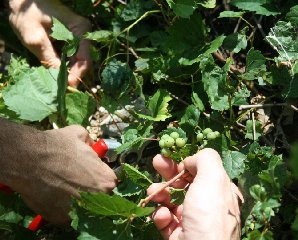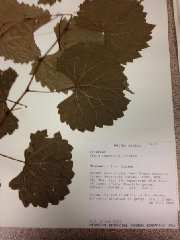Assoc. Professor, Saint Louis University; Research Associate, MBG
Research Interests
• Botany and plant evolution
• Population genetics and evolutionary genomics
• Economically and ecologically important plants
Web Page: SLU
Project: Identifying morphological traits associated with drought tolerance in grape: morphometric analysis of three North American grape species (Vitis acerifolia, V. riparia, and V. rupestris). Allison Miller integrates evolutionary and population genetics, genomics, field-, orchard-, and herbarium-collected morphological and phenological data, and Geographic Information Systems (GIS) databases. The long-term goals of my research program are to address fundamental evolutionary questions in crop systems and to contribute to the growing body of research facilitating crop improvement and the conservation of crop genetic resources.Naturally occurring variation found in locally adapted populations of crop wild relatives represents an important source of variation associated with abiotic (temperature, drought) and biotic (pests, pathogens) stress resistance. In Missouri, native grapes (Vitis spp.) have evolved in response to challenging climates such as extremely hot and humid summers, cold winters, and marginal soil conditions. Missouri grapevines are inter-fertile with one another and with the European grape (V. vinifera). In some ways, grapevines are unusual crops because cultivated varieties usually consist of two genetically distinct entities that are grafted to one another: the above-ground part of the plant (the scion) produces the stem, leaves, flowers, and berries, and the below-ground part (the rootstock) makes the lower stem and roots. Grafting in grapevine dates back to the mid-1800’s when insects in the genus Phylloxera devastated the French grape industry. Starting with this crisis, Missouri grapevines have been key genetic resources for the development of abiotic and biotic stress resistant rootstocks and hybrid grapes (Pongrácz, 1983; Galet, 1988). Indeed, today the bulk of the grape industry in France consists of European grapes growing on American Vitis roots, including many from Missouri.
Consequently, native Missouri Vitis species are important for local, national, and international grape and wine industries. The proposed project focuses on documenting morphological variation in a clade of three species of North American Vitis species. Two of these species (V. acerifolia and V. rupestris) are extremely drought-tolerant. Their sister taxon, V. riparia lives in wetter areas. What are the morphological differences that distinguish these taxa? The undergraduate researcher will work closely with Dr. Miller and SLU PhD student Laura Klein, and will be involved in collecting morphometric data in the MO herbarium, as well as fieldwork to augment existing collections. Morphometric data in conjunction with environmental data derived from GIS databases, will be used to identify morphological traits associated with dry areas.
Selected Publications
• Jaillon O., Aury J.-M., Noel B. et al. 2007. The grapevine genome sequence suggests ancestral hexaploidization in major angiosperm phyla. Nature 449: 463-467.
• Aradhya, M., Y. Wang, M. A. Walker, B. H. Prins, A. M. Koehmstedt, D. Velasco, J. M. Gerrath, G. S. Dangl, and J. E. Preece. 2012. Genetic diversity, structure, and patterns of differentiation in the genus Vitis. Plant Systematics and Evolution. 10.1007/s00606-012-0723-4.
• Miller A.J. and B.L. Gross. 2011. From forest to field: perennial fruit crop domestication. American Journal of Botany 98: 1389-1414.
• Myles, S., J. – M., Chia, B. Hurwitz, C. Simon, G. Y. Zhong, E. Buckler, and D. Ware. 2010. Rapid genomic characterization of the genus Vitis. PLoS One 5(1): e8219.
• Myles, S., A. R. Boyko, C. L. Owens, P. J Brown, F. Grassi, M. K. Aradhya, B. Prins, A. Reynolds, D. Ware, C. D. Bustamante, and E. S. Buckler. 2011. Genetic structure and domestication history of the grape. Proceedings of the National Academy of Sciences 108(9): 3530 – 3535.
• Schultz H.R. 2000. Climate change and viticulture: a European perspective on climatology, carbon dioxide and UV-B effects. Australian Journal of Grape Wine Research 6: 2-12.
• Zecca, G., J. R. Abbott, W. – B. Sun, A. Spada, F. Sala, and F. Grassi. 2012. The timing and mode of evolution of wild grapes (Vitis). Molecular Phylogenetics and Evolution 62: 736-747.
 |
 |